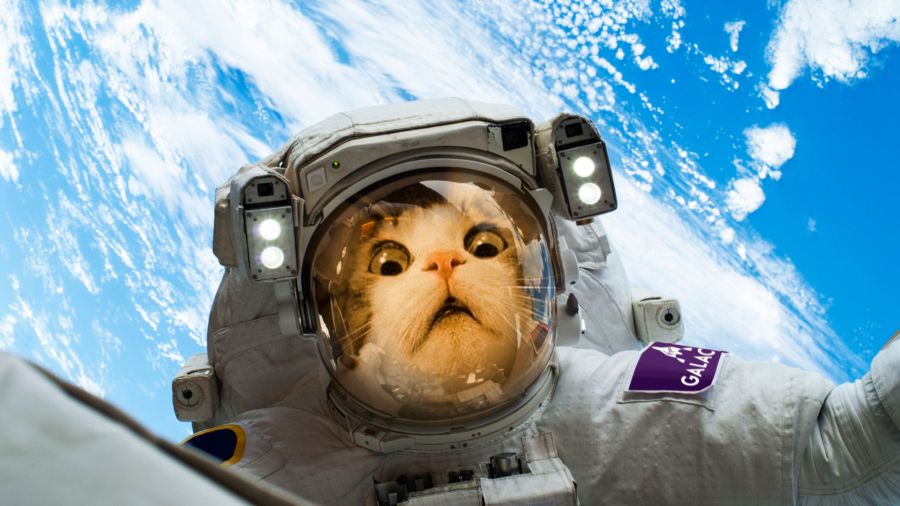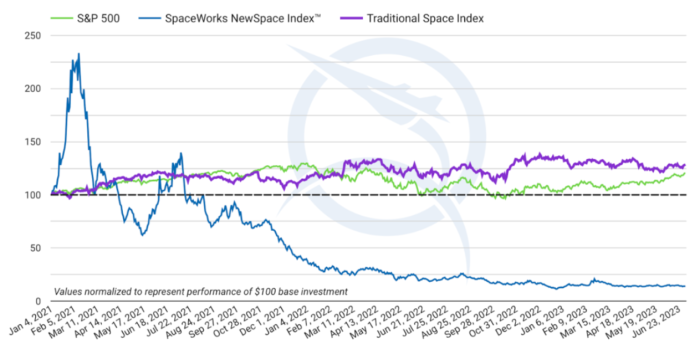
Receive free Space industry updates
We’ll send you a myFT Daily Digest email rounding up the latest Space industry news every morning.
Sinéad O’Sullivan is a former Senior Researcher at Harvard Business School’s Institute for Strategy and Competitiveness.
Touching the face of God never seemed so mundane.
A backdrop of space tourism mania in 2021 saw Richard Branson and Jeff Bezos go head-to-head in a heated race to launch crewed space vehicles.
Two years later, Virgin Galactic’s first commercial launch with paid customers on June 29th was… lackluster.
While they say that all press is good press, it appears that not even global attention highlighting commercial exploration endeavors via OceanGate’s Titan submarine could excite investors about Virgin’s latest milestone.
Sure, shares briefly broke the surly bonds of gravity…
…but the longer-term picture is rather less to the moon:
Can the space tourism hype rocket ever regain propulsion?
The space-sector-adjacent crowd can be divided into three broad groups based on their views of the Billionaire Space Race shenanigans.
— The first group are those who believe the hype (and its symbiotic organism, the grift) is a distraction from achieving Serious Science™ and exploration goals.
— The second is those who believe that commercial space tourism — regardless of how and by whom it is funded — will be of enormous value to humankind, because of something about understanding our unique place in the universe.
— Finally, there are those (largely outside of the industry itself) who wake up and pray to Elon Musk before checking the $SPCE stock price at the same time as their $DOGE wallet on Robinhood.
Regardless of which camp you fit into, the economics of Virgin Galactic’s offering — which will rely on High Net Worths forking out $450,000 for a 4-5 minute thrill — have become increasingly difficult to defend, even for the industry’s most ardent supporters.
Right now, VG has roughly 800 customers, most of whom have only paid a non-refundable $25,000 towards a deeply-discounted ticket price of $250,000. Hoping to begin commercial flights as early as 2008, the company is fifteen years late in starting to serve its demand backlog.
Meaning, the costs have been gravity-defying: Virgin Galactic’s net losses over the last three fiscal years have climbed to slightly over $1.1bn.
Last month’s flight brought in $600,000 — not much of a dent.
Assuming losses moving forward are equal to the lowest of those years ($273m, in 2020) and that each VSS Unity aircraft carries its maximum of six passengers at the full ticket price, Virgin Galactic will have to fly 102 times within a year to break even. That is a flight every 3-4 days.
But assuming its losses moving forward are the same as last year, $500m, Virgin will have to fly daily to break even. In the scenario of an $500m annual spend to serve hundreds of ticket prices at the $250,000 discounted rate, while only taking four instead of six passengers, Virgin Galactic would have to fly multiple times a day to stay in the black.
Given that 10% of VG’s capacity has been donated to research and science, these already challenging numbers begin to look more dire. Take into account natural delay factors such as weather and flight readiness windows, and the near-term business model looks unworkable.
The SpaceWorks “NewSpace Index”, which indexes and tracks space sector SPACs, highlights the difference between the relative weakness of loss-seeking space SPACs such as Virgin Galactic, and established groups such as Boeing and Northrup Grumman.
A rebalancing within the industry and a clear segmentation between the two types of space companies would be welcomed by space industry traditionalists who want to do Serious Science™ without worrying about billionaires and their dick jokes. Surprisingly, even many within the industry who defended these NewSpace industrialists for the sake of improving life on Earth and contemplating our human existence were silent about the launch.
And what about the “millions of kids all over the world who will be captivated and inspired about the possibility of them going to space one day”, to quote Richard Branson? Well,if they’re anything like investors they’ve probably moved onto the Next Big Thing — AI Discord servers, anyone?
I think what we’ve just witnessed is space tourism’s Dead Cat Launch.
Further reading
— Slaying space zombies
